|
|
|---|
Friday, March 31, 2006
Memorandum on the current situation in Ethiopia
Introduction
Following the demise of the other Ethiopian alternative forces by the Dergue and the creation of a ‘power vacuum’, the seizure of power by the TPLF/EPRDF in 1991 after the fall of the Dergue was received with a mixture of relief, skepticism and a general passiveness by the people of Ethiopia.
To some people who did not know the leadership of the TPLF properly, the end of the military regime seemed to be the end of terror and they hoped that peace would prevail and the recurrence of famine would be prevented by economic development. Those who felt relieved took the rhetoric on democracy by the new power holders at its face value and they expected changes for a better future. Those who received the TPLF with skepticism had also lack of information on the TPLF and gave the new regime the benefit of doubt.
For those, who knew the undemocratic nature of the TPLF leadership, it was easy to extrapolate from the past experience of the organization and foresee that the take over of power by the TPLF/EPRDF would be the continuation and extension of the tyrannical rule of Meles Zenawi all over Ethiopia, with dire consequences for the sovereignty of the country and human life. The TPLF had never practiced democracy in the organization, within the people of Tigray in whose name the struggle was waged and with other rival organizations throughout the course of the armed struggle. This was a source of concern that the country may get out of the frying pan, into the fire.
The EPRDF was therefore, neither welcomed nor opposed by mass rallies. The people were already made passive and incapacitated to take any concerted action, because they were intimidated and not allowed to freely organize themselves under the military regime.
As soon as it seized power, the TPLF/EPRDF regime, like an occupation force, began dismantling all national and state institutions such as trade unions, professional associations, and the national defense establishment to pave the way for ethnic politics. The regime pursued a policy of division, terror and control of the people by adapting its ethnic politics to its Stalinist form of organizational structure of centralism and hierarchy, thereby eroding human and democratic rights, the unity of the people as well as the territorial integrity and sovereignty of the country.
The TPLF leaders propagate the erroneous notion that ethnic based parties are the sole means of articulation and representation of interests of the people of any language group. The TPLF promoted this notion from its organizational programme, elevated it to a state policy and imposed it on Ethiopia by intrigues and brutal force. The current conflict between the TPLF and the opposition has its roots in this dangerous policy of the ruling party, which equates unity with domination and suppression.
The imprisonment and consequent accusation of the opposition leaders of inciting violence against the people of Tigray is a misleading act of irresponsibility. The charge of genocide and treason against the active and critical elements of the population is simply so ridiculous that this trumped-up charge will add up to the shameful crimes committed by the prime minister against Ethiopia and the Ethiopian people. This act is a last ditch attempt by the regime to mobilize the people of Tigray against any party which poses any threat to the absolute power of the mass murderer, Meles Zenawi. The people of Tigray have been living with their fellow Ethiopians for thousands of years in peace. For Tigrayans, Ethiopia is not a grant but their achievement; it is their identity. However, Meles Zenawi is driving a wedge between Tigrayans and Amharas, as he is doing between several ethnic groups.
Statement
The Prime Minister has failed Ethiopia in defending the sovereignty of the people and the territorial integrity of their country, internal peace and harmony. He is unwilling to free the people from the humiliating dependency on handouts for survival. The ruling group collaborated with enemies of Ethiopia to undermine Ethiopian unity and access to international waters. The regime conspired with forces, which wanted to benefit at the cost of Ethiopia and Ethiopians.
The current crisis is the creation of the leaders of the TPLF/EPRDF in general and that of the prime minister, who has an absolute power, in particular. The rigging of the elections, the use of ruthless force to suppress the legitimate rights of the people who demand the restoration of their verdict, the brutal crack down on the opposition and the press, the accusation of the opposition and the attempt to silence all concerned and critical elements of the society is upsetting the people, destroying peace, harmony and a sense of security. The regime is practicing a reign of terror. The Ethiopian people rejected Meles Zenawi and his clique in the polls and reiterated their rejection by defying his attempt to forcefully silence them and the opposition by force. More betrayal, suppression, lies and more court dramas orchestrated by Prime Minster Meles Zenawi and co. will not bring stability and peace in the country.
After examining the situation prevailing in Ethiopia in depth, we the undersigned Ethiopians from Tigray, out of devotion to the integrity of our country, peace and prosperity of its people, have issued the following declaration in full solidarity with all fellow Ethiopians.
1.We call for the immediate and unconditional withdrawal of the false and ridiculous charges of genocide and treason against the leaders and members of the opposition, the press people and other activists. We condemn the court drama against the members of legally registered political parties and their leaders, who have been elected in the May 2005 elections and all prisoners of conscience. We call for their immediate and unconditional release.
2.The Prime Minister is responsible for the series of massacres which have been committed in Ethiopia (in Gambella, Awassa, Jimma, Gonder, four times in Addis Ababa etc.), for the incarceration of citizens with concocted accusations, for wreaking havoc amongst the Ethiopian People and misusing the name of the people of Tigray in this connection. Meles Zenawi is also a danger for the territorial integrity and sovereignty of our country as he has been repeatedly showing his anti-Ethiopian position in connection with the conflict with Eritrea. It has to be born in mind that his machinations of creating ethnic contradictions is also part of his scheme to abort a united opposition against his policy of eroding Ethiopian sovereignty
3.We condemn the use of lethal means against demonstrators and the sinister act of sowing ethnic conflicts. We call for the release of all political prisoners, the closure of all the concentration camps and an end to the violent suppression of the democratic and human rights of the people. We oppose the suppression of all-Ethiopia institutions and/or encompassing organizations that had hitherto been promoting nation-wide unifying agendas.
4.We call for the resignation of Meles Zenawi as Prime Minister of the country and as chairman of the EPRDF to create a conducive atmosphere for members of TPLF/EPRDF, who have not committed crimes against humanity to make a fresh start and commence negotiations with all opposition parties based on the results of the May 2005 elections and form a government of national unity with the objective of eradicating the politics of hate and organizing an early democratic election.
5.We call upon the members of the TPLF/EPRDF, who have not committed crimes against humanity, opposition forces, human rights activists, civic and professional organizations to organize a platform of national reconciliation and the unity of the Ethiopian people should be given utmost priority.
6.We call upon all democratic and patriotic Ethiopians to examine the current political crisis in Ethiopia beyond ethnicity and local interests. Ethiopian unity is at stake and we must constantly and vigilantly combat ethnocentric politics that could undermine our unity. Each and every Ethiopian has an historical obligation to secure the unity of the Ethiopian people.
1. Abraha Belai
2. Mamu Gebre Medhin
3. Berhane Girmay
4. Teka Kesete
5. Godofai T. Giorgis
6. Mehari Abera
7. Gebre Medhin Araya
8. Haile Selassie Yohannes
9. Beyene Gebray
10. Berhe Abay
11. Ghirmay Gezehegn
12. Ghidey Zeratsion
13. Aregawi Berhe
14. Dr. Gidey Assefa
15. Tesfay Atsbeha
16. Kahsay Berhe
Thursday, March 30, 2006
March 29, 2006 - Crucible of Hope
 This evening I preside at Madeline’s funeral. She’s the church member in her fifties who died in hospice care several weeks ago, after a long struggle with ovarian cancer. The family decided to wait a couple of weeks until I was through my most recent chemo treatment, so I could conduct her service.
This evening I preside at Madeline’s funeral. She’s the church member in her fifties who died in hospice care several weeks ago, after a long struggle with ovarian cancer. The family decided to wait a couple of weeks until I was through my most recent chemo treatment, so I could conduct her service.I remember when Madeline was first diagnosed. Her prognosis was not very encouraging, but she and her husband Dave stepped right up to the challenge, learned as much as they could about the disease and pursued aggressive treatment for as long as it seemed medically advisable to do so. I remember one night when they came into the Disciple Bible Study group I was teaching, and distributed educational materials about ovarian cancer to their fellow class members. They were on a mission that night: they wanted other women (and the men who love them) to know about the disease, and about the importance of early detection. It was just like Madeline – who combined deep caring for others with a no-nonsense, practical attitude – to do something like that.
Tonight I do feel well enough to conduct her service – but only just. A week after the most difficult of my chemo treatments so far, I don’t have a lot of stamina. It’s a good thing the funeral service is composed of a number of short segments. With Robin assisting me, I’m able to limit the time on my feet, and get through it without much difficulty.
Last week, when Dottie – my Presbyterian-minister colleague – stopped by to visit me during my chemo treatment, one of the pieces of advice she gave me was, “Don’t be a hero.” From her own experience as a cancer survivor – and perhaps knowing, also, that I’m the overly-conscientious type – she was encouraging me to take whatever time I need to get better, and let others handle my tasks at the church. I hear what she was saying, and I know I don’t absolutely need to be here tonight (Robin could very capably handle the service). Yet, in another sense, I do need to be here. What I need to do tonight is not something very many other people could do in my place. It’s a Cancer Underground sort of thing.
It’s hard to put into words, but I have a sense, tonight, that Madeline and I had a special connection because of our cancer. I choose to read these words from the letter to the Romans about suffering and endurance, because they somehow speak to our common experience:
 “...we also boast in our sufferings, knowing that suffering produces endurance, and endurance produces character, and character produces hope, and hope does not disappoint us, because God’s love has been poured into our hearts through the Holy Spirit that has been given to us.” (Romans 5:3-5)
“...we also boast in our sufferings, knowing that suffering produces endurance, and endurance produces character, and character produces hope, and hope does not disappoint us, because God’s love has been poured into our hearts through the Holy Spirit that has been given to us.” (Romans 5:3-5)I haven’t figured out, in advance, exactly what to say about this passage, so I just wing it. I speak about sickness as a stern and demanding teacher. The lessons people like Madeline and me learn from our illness are not the sort that can be put into words. They have more to do with who we are becoming, as a result of the experience. The fact that Madeline is no longer a cancer survivor, while I still am, is incidental. Our faith assures us there is life after death, and that therefore this hope, born of endurance and character, carries us onward into the life to come.
 The image that comes to my mind, as I think later about what sort of thing cancer teaches, is that of an Olympic skater. These athletes put themselves through years of demanding training, in order that they may become the sort of people they know they are meant to be. There are falls and injuries along the way. Sometimes the falls happen in competition, and that is painful to behold – but they get up and skate on. Maybe the most important trait these athletes need, in order to become champions, is this very ability to get up, again and again, after they have fallen.
The image that comes to my mind, as I think later about what sort of thing cancer teaches, is that of an Olympic skater. These athletes put themselves through years of demanding training, in order that they may become the sort of people they know they are meant to be. There are falls and injuries along the way. Sometimes the falls happen in competition, and that is painful to behold – but they get up and skate on. Maybe the most important trait these athletes need, in order to become champions, is this very ability to get up, again and again, after they have fallen.One thing I find noteworthy about the Romans passage is that Paul does not seem to consider character to be a given. Most of us consider character to be the result of having come from a good family, having had the right upbringing, and so forth. But his is a more dynamic idea of character. It’s not anything we can take credit for. It’s what life makes of us, in the mysterious providence of God.
Back home after the service, Claire tells me my voice was not so strong as it usually is. She could see my physical weakness as I stood at the pulpit, and probably others could, too. Yet in another sense, I feel strong, stronger than I’ve ever been before. That’s all because of suffering, which produces endurance, character – and hope.

Wednesday, March 29, 2006
March 28, 2006 - Poster Child?
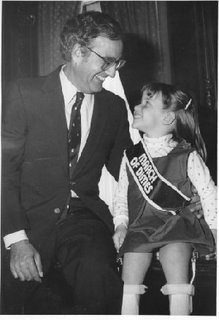 When I was a kid, the March of Dimes was a charity that sought to end polio (the fact that they started out soliciting dimes tells you how long they’ve been around). I was in elementary school when the oral form of the Salk polio vaccine came out. I can still remember the novel experience of my mother telling my brother, Jim, and me that it was time to drive downtown, so we could eat a sugar cube which contained the liquid vaccine. My mother, ever wary of our dental health, was not inclined to let us eat sugar cubes, so this jaunt seemed a truly noteworthy event. (Jim and I agreed that, if nothing else, the sugar cube sure beat a hypodermic needle.)
When I was a kid, the March of Dimes was a charity that sought to end polio (the fact that they started out soliciting dimes tells you how long they’ve been around). I was in elementary school when the oral form of the Salk polio vaccine came out. I can still remember the novel experience of my mother telling my brother, Jim, and me that it was time to drive downtown, so we could eat a sugar cube which contained the liquid vaccine. My mother, ever wary of our dental health, was not inclined to let us eat sugar cubes, so this jaunt seemed a truly noteworthy event. (Jim and I agreed that, if nothing else, the sugar cube sure beat a hypodermic needle.)After the Salk vaccine, polio was more or less eradicated in short order. Rather than closing up shop, the March of Dimes cast around for a new mission. They settled on the worthy cause of preventing birth defects. From their polio-fighting days, they had learned the value of naming a “poster child” each year. This was generally a cute-looking pre-schooler, who could be portrayed on promotional posters wearing leg braces or using crutches. The purpose of the poster child was to get sympathetic donors to part with their dollars (the organization having long since left mere dimes behind). We used to see the poster children’s pictures on change canisters in stores. They always seemed a bit sad. I never dreamed I might be one.
Recently, I’ve agreed to become a poster child of sorts – at least for one particular project, the raising of money for lymphoma research. Dana, a member of our church who works for Genentech (the company that makes Rituxan, the lymphoma miracle drug I’m receiving), is quite attuned to the ongoing need for research funds. She suggested that the church organize a fund-raising walk to aid the Lymphoma Research Foundation. Tom (another church member who’s principal of the local elementary school), and Mandy (our youth director) have responded enthusiastically to the idea - although we’re hoping for participation from all ages, not just the youth group. As of today, we’ve got a date (Sunday evening, April 30th, a place (the Antrim School) and a gimmick to set the event apart (a night-time walk with participants carrying glow-sticks for the dramatic effect).
 I take it as a gesture of personal support and empathy for my situation, and am glad to receive it in that spirit. I’ll plan to come to the event to give the walkers moral support, though I may not have energy for more than a symbolic walk around the school track.
I take it as a gesture of personal support and empathy for my situation, and am glad to receive it in that spirit. I’ll plan to come to the event to give the walkers moral support, though I may not have energy for more than a symbolic walk around the school track. Sure, I’ll be a poster child for a good cause...
Congressional Hearing on Ethiopia’s Troubled Internal Situation

Photo By Endale Getahun ECTV
[Congressman Chris Smith poses for picture with Mr. Obang Metho]
Yesterday's (March 28, 2006) Congressional hearing on the deteriorating situation in Ethiopia highlighted the Zenawi administration’s disturbing journey towards complete totalitarianism.
Mr. Donald Y. Yamamoto, deputy assistant secretary for African Affairs was the first to testify. Mr. Yamamoto gave the usual lukewarm, wishy-washy speech he’s been giving for the past six month. His testimony made it very difficult to predict what the U.S government plans to do, other than sit on the side lines hoping for a favorable outcome.
“Ethiopia is currently at a crossroads; it can continue to move forward, or it can lapse into the sort of government that’s best encountered in history books.”Ethiopia is no longer at a crossroads. Mr. Zenawi’s government has decided which path it would take, and it is not “forward”. The “government that’s best encountered in history books” is already a reality.
Mr. Donald Y. Yamamoto
Ambassador Fesseha A. Tessema was the next to testify. With a straight face he informed the audience that there are no political prisoners in Ethiopia. This drew chuckles from the crowd. Chairman of the subcommittee, congressman Chris Smith asked the ambassador if reports of political detainees by amnesty international and other major organizations were false; to which the ambassador replied, we used to have political prisoners but now they are all released and all that remain are 170 something criminals that are charged. (Crowd murmurs in disapproval)
Congressman Chris smith concluded the ambassador’s testimony by asking the government of Ethiopia to release all opposition prisoners as a show of good will. (crowd erupted into wild cheers)
Mr. Andargachew Tsege was the next to testify, he urged the U.S to act
“It is both a moral and strategic imperative that America's leaders demand the immediate release of all political prisoners, without preconditions.When the time came for Mr. Obang Metho to testify, most in the crowd and those watching the live feed had no idea who he was. Some were speculating he may be an official of the AU, others thought he was the leader of the new armed opposition group “patriotic front”.
The continued support of this tyrant will prolong the misery of Ethiopia.”
But Mr. Metho belonged to none of those groups. He was the Director of International Advocacy, Anuak Justice Council (AJC): a little known organization to many Ethiopians. As we reported yesterday, Mr. Metho’s testimony was the highlight of the whole hearing. Articulate and very passionate, he captivated everyone’s attention. It was so quiet in the auditorium; you could hear a pin drop.
Mr. Metho’s testimony is one that will be talked about for years to come."My name is Obang Metho. I am an Anuak. I grew up in Gambella. I am not here as part of a political party. I am not here as an expert. I am here as a witness and human rights defender to speak up for the 424 educated Anuak who were massacred on December 13, 2003 and who can no longer speak up for themselves. I am here for the children who lost their fathers on that day. I am here as the voice of the woman who lost her husband or son and for the grandparent who lost their grandchild. I am here to speak for the families whose husbands, sons and fathers have been in prison for years with little hope of release. I am here for the four thousand Anuak refugees in Pochalla, Southern Sudan who still cannot return home………… But, I am not only here today for the Anuak. I am here for the Tigrayans who disagree with their own government. I am here for the Oromo, the Somali, the Afar and for any in other ethnic groups throughout Ethiopia who have been oppressed. I am here for the Ethiopian woman whose son or daughter was shot dead on the streets of Addis Ababa after the national elections. I am here for the CUD leaders and young student protesters who have been taken away from their families and put in prisons and detainment centers. I am here for those courageous prisoners of conscience, languishing in prisons throughout Ethiopia"
Dr. Mekdes Mesfin, daughter of Professor Messfin w/mariam was eloquent and to the point:
“I respectfully urge the continued attention to these points I have mentioned in considering the most meaningful legislative steps to take. Not just because Mesfin is my father, but also because of the strength of his commitment his track record as a peaceful advocate of the people during three successive regimes, his exemplary academic and social contribution and his faith in the democratic process and the rule of law, my biggest wish is that this man who will turn 76 in a few weeks, will live to see the empowerment of his people.”The last person to testify was Ms. Lynn Fredricksson, Advocacy Director for Africa (Amnesty International).
Amnesty International holds that the charges of “treason,” “organizing and inciting armed rebellion” and “acts of genocide”1 levied against some 1312 CUD leaders, human rights defenders and journalists (most of whom are in physical custody) have no merit.”And then she proceeded to name names:
“These prisoners of conscience, who were peacefully exercising their rights to freedom of speech, association, assembly and press, include:Before the hearings concluded Congressman Chris Smith informed the audience of the plan to change the name of the bill from “Ethiopia Consolidation Act of 2005” to something more potent that may include words like “freedom” and “democracy”. He also promised to strengthen the bill by adding more measures that will help insure democracy in Ethiopia.
Hailu Shawel (70), president of the CUD
Professor Mesfin Woldemariam (75), former chair of the Ethiopian Human Rights Council(EHRCO)
Dr. Yakob Hailemariam, former UN Special Envoy and former prosecutor at the InternationalCriminal Tribunal for Rwanda
Ms. Birtukan Mideksa, former judge and CUD vice president
Dr. Berhanu Negga, recently elected mayor of Addis Ababa and professor of economics
Daniel Bekelle, anti-poverty activist working for ActionAid, an international development NGO
Netsanet Demissie, anti-poverty activist heading the Organisation for Social Justice in Ethiopia(OSJE)”
Meeting adjourned.
Complete transcript of Yesterdays testimonies:
The Honorable Donald Y. Yamamoto
Mr. Andargachew Tsege
Mr. Obang Metho
Meqdes Mesfin, M.D
Ms. Lynn Fredricksson
Tuesday, March 28, 2006
Mr. Obang O. Metho
The following is an excerpt from his speech:
"But, I am not only here today for the Anuak. I am here for the Tigrayans who disagree with their own government. I am here for the Oromo, the Somali, the Afar and for any in other ethnic groups throughout Ethiopia who have been oppressed. I am here for the Ethiopian woman whose son or daughter was shot dead on the streets of Addis Ababa after the national elections. I am here for the CUD leaders and young student protesters who have been taken away from their families and put in prisons and detainment centers. I am here for those courageous prisoners of conscience, languishing in prisons throughout Ethiopia."
To read the complete transcript of Mr. Metho’s testimony click here
March 27, 2006 - Cumulative

The word for the day is: cumulative.
I read somewhere, a while back, that chemotherapy side effects are often cumulative – the longer one goes through this process, the longer they take to dissipate. This has certainly been true this time around.
I’ve written, before, about the prednisone rush. In previous cycles this has happened to me on the afternoon of the fourth and final day of taking these powerful steroid tablets. Symptoms include hot flashes, headache, nervous energy and a general emotional feeling that’s something like sitting behind the wheel of a car, flooring the accelerator and listening to the wheels spin. There’s a pervasive exhaustion that goes along with it, but it’s nothing a nap will fix. It’s hard to sleep at all, in fact, despite the run-down feeling.
This time around, the prednisone side effects began a day early, and they’re still with me now, a couple of days after taking my last pill. I’m profoundly tired of this unpleasant, jittery feeling, but this time it just won’t seem to go away.
This morning Claire happens to be home, and I suggest we go out for lunch. It’s a beautiful, spring day at the Jersey Shore, and I feel the need to get out of the house. We stop for a sandwich at a local seafood place, then head over to the boardwalk.
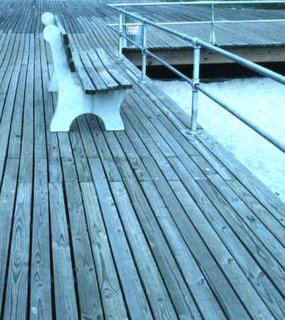 I quickly find that the prednisone rush isn’t the only chemotherapy side effect that’s cumulative. So is physical exhaustion. I find it hard to walk any distance at all along the boardwalk, without stopping to sit on a bench and catch my breath. I used to walk the whole mile-long length of the Point Pleasant Beach boardwalk for exercise, up and back, without thinking much about it – but the thought of that amount of walking seems completely impossible now. My progress these days is measured not in miles, but in feet.
I quickly find that the prednisone rush isn’t the only chemotherapy side effect that’s cumulative. So is physical exhaustion. I find it hard to walk any distance at all along the boardwalk, without stopping to sit on a bench and catch my breath. I used to walk the whole mile-long length of the Point Pleasant Beach boardwalk for exercise, up and back, without thinking much about it – but the thought of that amount of walking seems completely impossible now. My progress these days is measured not in miles, but in feet.I feel a sense of loss that doesn’t seem diminished by the thought that these side effects are likely only temporary. The fact is, right now I couldn’t walk the length of the boardwalk if I tried. I’ve lost that physical capability. I feel older than my years.
I’m dealing, now, with my fourth chemo treatment out of six. Emotionally, it’s a difficult spot to be in. I’m more than halfway through, but – knowing that the cumulative effects will only increase – it still seems like I’ve got a very long way to go.
Just keep putting one foot in front of the next. Take it slow. Stop and breathe, when you need to. It’s the only thing to do...

Monday, March 27, 2006
Faces of a Dictator
EPRDF’s officials are running Ethiopia applying the slave (capo) mentality, a slave who has been promoted to a higher rank by his master and is willing to do anything to keep his status. It is part of the job description for such a slave to oppress those beneath him (his fellow slaves) so they will not dare challenge his authority and keep his masters happy by tending to their every need.
This mentality is what earned Prime Minister Meles Zenawi the “progressive leader” label in Europe and the “dictator” label in his own country. Premiere Meles is convinced his authority comes from his western donors and considers citizens in his country as inconsequential.
Last Tuesday Charges were dropped for 18 defendants who had been accused by the government of genocide and treason. This follows a recent visit by a top western diplomat who at a meeting with EPRDF officials demanded on behalf of the U.S government that charges brought up against U.S employees be dropped ASAP. A few weeks to save face and voila! charges are dropped.
There are two versions of Mr. Zenawi. Most English speaking Ethiopians have known this for years. His lack of respect for his fellow citizens and his unholy reverence of foreigners is clearly depicted in his speeches. His Amharic speeches are designed to scare and intimidate Ethiopians while his English speeches are designed to appease and please the west.
Here’s one example:
On July of 2005 Mr. Zenawi made the following statement on HardTalk to BBC's Stephen Sackur
“Leaders have to stay as long as the people want them to stay, and do so through freely-contested elections. The decision has to be that of the people in the final analysis. ……..The longevity of political leaders, in my view, depends on the quality of the democracy in the country. ………however, more frequent changes of leaders is a safer and healthier approach.”
Just a few days earlier he had made the following statement in Amharic on the state run ETV....
“These are the four choices that are facing opposition leaders at the moment
1) Go into exile
2) pick up arms and engage in armed struggle
3) submit and live quietly
4) Languish in detention for the rest of your lives.”
This translation may seem exaggerated to some who only know the “well mannered” side of Mr. Zenawi, but Ethiopians who had heard that speech in “Amharic” will no doubt attest that we have in fact watered it down a bit.
What distinguishes the current government of Ethiopia form those in the past is not its dedication to democracy as some have suggested but rather its willingness to bend over backwards to be on the good side of its donors.
It will be interesting to see what will happen the day the U.S stops calling for a fair trail and demands an unconditional release of all political prisoners, human rights activists and journalists.
Sunday, March 26, 2006
March 26, 2006 - Thinking About the Garden

"Thinking About the Garden"
I’m thinking today about the Garden
(which I suppose is a good thing,
because it means I’m not thinking
about the cancer).
The Garden
is a small plot of ground
off to the side of the Manse,
tucked between the concrete drive
and the gray-shingled house.
Each Spring about this time,
for each of the fifteen Springs we’ve lived here,
Jake, the Sexton,
has come, unasked,
gripping his Roto-Tiller’s handles,
to churn and turn
the clods for me,
so I could claim
my suburban squire’s privilege
of pressing a few tomato seedlings
into the moist earth,
and of savoring the distant hope
of a taste of vine-warm fruit
at some steamy summer cookout yet to come –
a cascade of sweet, red juice
“running down upon the beard,
on the beard of Aaron
running down over the collar of his robes.”

Jake’s retired now.
There is no more Sexton
(sorry, budget cutbacks).
We have a cleaning service
and a grounds service, too:
efficient,
economical,
anonymous.
(A pity.)
“Sexton,” propounds the Oxford Dictionary,
comes from sacristanus (Old Latin):
“A person responsible
for looking after a church,
its contents,
and the churchyard,
frequently acting as bell-ringer
and gravedigger.”
The sacristanus handles sacred things,
like clods of moist, brown earth.
We never did permit Jake to handle
the sterling silver trays of yeasty bread cubes,
nor the sweet, Presbyterian grape juice,
decanted from Dr. Welch’s bottle
into plastic cups.
He was a man of the earth,
with dirty hands to show for it.
Those tasks belong to the Deacons
in their proper Sunday suits and dresses:
they who ascend the hill of the Lord
with clean hands
and a pure heart
(or so goes the theory).
There is no sacristanus to churn the earth for me,
churn it like the waters of Bethesda’s pool,
so it may yield its increase.
(More’s the pity.)
One bright day,
slowly,
hoe in hand,
I will do it myself.
Indeed it is a good thing
that I am thinking about the Garden,
because it means I’m not thinking
about the cancer.

Saturday, March 25, 2006
March 24, 2006 - Looking Sick
 Yesterday my missing CT scan films finally arrived from Sloan-Kettering. This afternoon I notice them sitting by the front door, and I know Claire will be out for the rest of the afternoon doing hospice ministry, so I decide to drive them over to Ocean Medical Center myself.
Yesterday my missing CT scan films finally arrived from Sloan-Kettering. This afternoon I notice them sitting by the front door, and I know Claire will be out for the rest of the afternoon doing hospice ministry, so I decide to drive them over to Ocean Medical Center myself.It’s more tiring than I would have thought, just walking from the parking garage over to the main building. I go slow, huffing and puffing along the way. I have very little stamina for physical exercise. The only experience I have to compare this to was last spring, when I went out to a national Presbyterian pastors' retreat at the Snowbird ski resort in Utah. That place was around 8,000 feet above sea level. With the thinner air at that altitude, I had the unaccustomed experience of thinking consciously about my own breathing.
I find my way to the X-Ray File Room, which is where CT films are kept. A staff member from that department is coming out of a side door as I’m walking down the hall with my large envelope, and she asks me if I’m returning films. I say, yes I am, but also explain that Dr. Lerner wants me to ask her to pass on the word to the radiologist that these are now in, in case that doctor wants to make a supplementary report, based on the actual films (rather than just the narrative report from last fall). Evidently, there’s no release to sign, no form to fill out – so I just hand over the envelope. (All the films have my name on them, and the date, so there doesn’t seem to be much chance they’ll get lost – but the whole transaction still seems very informal, especially since it's happening out in the hallway.)
She says she’ll take care of it, and not to worry about it. She seems unusually solicitous, and it occurs to me that I may not look too good at the moment. I’m feeling tired, my eyes are glassy, and my complexion is probably closer to gray than any other color. She’s treating me like a sick person, I think to myself. Well, that’s what I am, especially just a couple of days after chemotherapy. Sometimes I forget that I don’t look the same as I always have.
 Is that a good thing, to be treated as a sick person? I’m not sure. On the one hand, the hospital staffer seems very kind, but on the other, I feel, in that moment, somehow set apart from the rest of the human race. I’m different, I think to myself. I look different, and this person is treating me differently.
Is that a good thing, to be treated as a sick person? I’m not sure. On the one hand, the hospital staffer seems very kind, but on the other, I feel, in that moment, somehow set apart from the rest of the human race. I’m different, I think to myself. I look different, and this person is treating me differently.Thinking back on the experience later, I wonder if that’s how older people feel. I’ve seen people fussing around and being solicitous of the elderly. At times I’ve done so myself. Those actions are of course well-meant, but I suppose that, from the standpoint of the recipient, they could unintentionally contribute to a sense of isolation.
File that one away as a lesson for the future, I think to myself. One more lesson from Cancer: that stern, master teacher.
Thursday, March 23, 2006
Boy, the world is moody
Moodgrapher is a Global mood analysis tool! It plots the mood levels reported by LiveJournal users in their posts during the last days, updated every 10 minutes.
Interesting to see the connection between moods and both cyclical and global events.
For example:
* Drunk is highest around the weekend
* Happiness around Christmas 2005
* Thankful, hungry, and full around Thanksgiving 2005
* Scaredness around Halloween 2005
* Mass increase in the level of worriedness around major weather phenomena, such as hurricane Katrina on August 29, 2005
* Excitedness around global media and culture events, such as the release of a new Harry Potter book on July 15, 2005
* Mass increase in the level of distress and sadness after terror attacks, as witnessed by the response to the London bombings on July 7, 2005
Not necessarily scientific, but definitely interesting!
March 22, 2006 - Chemo 4, and Some Good News
 This morning at 9:30 Claire and I drive over to Dr. Lerner's office for my fourth chemotherapy treatment. I go in by myself first, to step onto the scale and then have my porta-cath flushed in preparation for the chemo drugs. At my request, Raquel, the nurse, uses a larger needle to access my porta-cath – I had problems with the smaller needle reaching the deeply-implanted device on a previous visit – but now it appears that the prior problem was due to post-surgical swelling, which has now resolved itself. A regular-sized needle would have done fine. Raquel consults with a couple of the other nurses, and they decide to go ahead and leave the larger needle in (rather than removing it and sticking me a second time), even though there's a risk of it catching on something and being pulled out. They put a thick wad of gauze under its protruding end to support it, and cover the whole arrangement with a lot of adhesive tape. It seems pretty secure. Raquel then draws my weekly blood sample through the porta-cath. With a plastic cylinder that looks like the fluid-reservoir of a hypodermic needle taped to my shirt, I go down the hall into an examining room, where Claire joins me.
This morning at 9:30 Claire and I drive over to Dr. Lerner's office for my fourth chemotherapy treatment. I go in by myself first, to step onto the scale and then have my porta-cath flushed in preparation for the chemo drugs. At my request, Raquel, the nurse, uses a larger needle to access my porta-cath – I had problems with the smaller needle reaching the deeply-implanted device on a previous visit – but now it appears that the prior problem was due to post-surgical swelling, which has now resolved itself. A regular-sized needle would have done fine. Raquel consults with a couple of the other nurses, and they decide to go ahead and leave the larger needle in (rather than removing it and sticking me a second time), even though there's a risk of it catching on something and being pulled out. They put a thick wad of gauze under its protruding end to support it, and cover the whole arrangement with a lot of adhesive tape. It seems pretty secure. Raquel then draws my weekly blood sample through the porta-cath. With a plastic cylinder that looks like the fluid-reservoir of a hypodermic needle taped to my shirt, I go down the hall into an examining room, where Claire joins me.Dr. Lerner comes in, greets us, and opens my file – which, I can see, is growing. It's now a couple of inches thick. First, the news we've been waiting for – and it's good news. The CT scan reveals that the mass in my abdomen has shrunk to about half its original size: from 93 square centimeters to about 45. This, says the doctor, is good progress. Evidently, the radiologist who read the scan was able to make this judgment using the narrative report from my original CT scan – although it would have been better to do a side-by-side comparison of the actual films. Dr. Lerner suggests that, when I do receive the original films back from Sloan-Kettering, I take them over to Ocean Medical Center with a request that the radiologist do a supplemental report.
Dr. Lerner's plan is to continue with the same chemotherapy regimen I've been undergoing, because clearly it's working. At the end of the sixth treatment, I'll have another CT scan – although he warns me that, because I have a large tumor, it may show some residual tissue remaining. Generally, this is fibrous, scar-like tissue, and not a threat – although he says he'll probably want to order another PET scan, just to make sure no "hot spots" show up.
 Dr. Lerner does give us a new piece of information. He says there's a possibility that, once the chemo sessions are ended, I may need to have radiation treatments. This is sometimes done with patients like me, who have larger tumors that can be clearly targeted. I ask him about the duration of these treatments, and he says they would probably last for three or four weeks – a series of very brief, daily visits. Another doctor, a radiation oncologist, would determine the schedule and oversee the treatments. When I ask him about the other tumors that showed up on my previous PET scan, he doesn't use the word "tumors" in his response, but rather refers to them as "hot spots." Clearly, his main focus is on the large abdominal tumor; he'll check on the other areas at the time of my post-chemo PET scan.
Dr. Lerner does give us a new piece of information. He says there's a possibility that, once the chemo sessions are ended, I may need to have radiation treatments. This is sometimes done with patients like me, who have larger tumors that can be clearly targeted. I ask him about the duration of these treatments, and he says they would probably last for three or four weeks – a series of very brief, daily visits. Another doctor, a radiation oncologist, would determine the schedule and oversee the treatments. When I ask him about the other tumors that showed up on my previous PET scan, he doesn't use the word "tumors" in his response, but rather refers to them as "hot spots." Clearly, his main focus is on the large abdominal tumor; he'll check on the other areas at the time of my post-chemo PET scan.My blood tests continue to look pretty good. My white cell count is a little below normal, but only slightly – and the Neulasta injection I'll get tomorrow should resolve that.
 Dr. Lerner asks about side effects, and I tell him I've been having some trouble with nausea for several days after each chemo treatment – even with the Aloxi they've been giving me intravenously on treatment days, and with the Compazine tablets I've been taking as needed. I remind him that, on my last blood-test visit, Raquel (after checking with him) gave me some samples of Kytril, another anti-nausea drug. I've been holding onto these pills at home, so as to start taking them following this week's treatment. Dr. Lerner says that, besides the Kytril and the Aloxi, he'll prescribe another anti-nausea drug, a new one called Emend. He first asks me if I have a prescription plan – evidently, this drug is expensive. Raquel had asked me the same thing, a couple weeks before, about the Kytril – the samples were of course free, but she was thinking about subsequent prescriptions. What price comfort?
Dr. Lerner asks about side effects, and I tell him I've been having some trouble with nausea for several days after each chemo treatment – even with the Aloxi they've been giving me intravenously on treatment days, and with the Compazine tablets I've been taking as needed. I remind him that, on my last blood-test visit, Raquel (after checking with him) gave me some samples of Kytril, another anti-nausea drug. I've been holding onto these pills at home, so as to start taking them following this week's treatment. Dr. Lerner says that, besides the Kytril and the Aloxi, he'll prescribe another anti-nausea drug, a new one called Emend. He first asks me if I have a prescription plan – evidently, this drug is expensive. Raquel had asked me the same thing, a couple weeks before, about the Kytril – the samples were of course free, but she was thinking about subsequent prescriptions. What price comfort?After concluding our time with Dr. Lerner, I walk with Claire to the other end of the building, where I take my seat in the same corner treatment room. Janet, my nurse for the day, begins the Benadryl drip, then the Rituxan not long after that. The medicine makes me drowsy, as it's done before, and I doze through most of the morning. Claire returns around noon, bringing my new Emend anti-nausea prescription – the first pill of which I need to start taking about an hour before I start on the CHOP chemo drugs (these don't start until I've finished the four- or five-hour Rituxan drip, so there's still time). I don't know what the original cost of the Emend prescription is, but our share, after the prescription plan kicked in, is about $85. This is for three pills.
A couple of friends stop by this afternoon, for surprise – and very welcome – visits. Dottie, a retired minister from our presbytery who's receiving treatment for ovarian cancer, stops by to offer encouragement and a prayer. Then, a little while after she leaves, Don – the member of our church who also has NHL – looks in. Both have been in today to see doctors from the same medical group, and ran into Claire in passing, so they realized I must be back here and stopped by to say hello. Both are well-known to the chemo nurses and very familiar with the whole treatment routine.
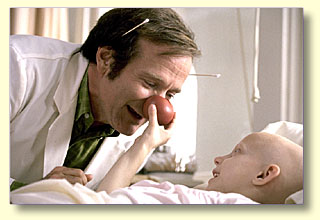 After my visitors leave, I watch a video I've brought along with me. In this age of DVDs, the video selection in our local Blockbuster store is getting sparse, but last night I did find a videocassette version of the 1998 Robin Williams film, Patch Adams. It's about an iconoclastic young doctor's journey through a rather traditional medical school, and how he manages to chart his own course – despite opposition from some hidebound professors – in the direction of a more holistic, personal way of treating patients. I had heard that the film – while based on a real person – is highly fictionalized. That's obvious from the script, some of which is just too unbelievable – typical Hollywood! But Robin Williams makes it entertaining, with his special blend of humor and compassion. The movie raises some provocative questions for modern medicine, which all too often treats patients as cases rather than people. (Not that I have any complaints about Dr. Lerner or his staff in that regard – they're very caring.)
After my visitors leave, I watch a video I've brought along with me. In this age of DVDs, the video selection in our local Blockbuster store is getting sparse, but last night I did find a videocassette version of the 1998 Robin Williams film, Patch Adams. It's about an iconoclastic young doctor's journey through a rather traditional medical school, and how he manages to chart his own course – despite opposition from some hidebound professors – in the direction of a more holistic, personal way of treating patients. I had heard that the film – while based on a real person – is highly fictionalized. That's obvious from the script, some of which is just too unbelievable – typical Hollywood! But Robin Williams makes it entertaining, with his special blend of humor and compassion. The movie raises some provocative questions for modern medicine, which all too often treats patients as cases rather than people. (Not that I have any complaints about Dr. Lerner or his staff in that regard – they're very caring.)Claire returns about 5:00, and we leave about 5:30 – after stopping on the way out to schedule my next several weeks of blood tests, and my next chemo treatment for April 12th.
Tuesday, March 21, 2006
Historical footage
(Length - 49min 39sec)
Monday, March 20, 2006
March 20, 2006 - In Praise of DIY
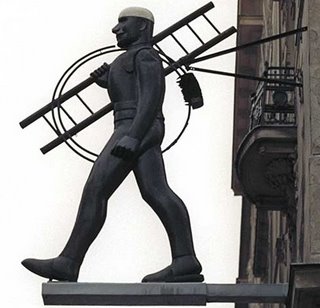 When Claire and I were living in Scotland some years back, we’d occasionally come across a “DIY Store.” We soon learned the initials stand for “Do It Yourself.” A DIY Store is one that sells home-improvement and craft items, for the amateur carpenter, plumber, electrician or other tinkerer.
When Claire and I were living in Scotland some years back, we’d occasionally come across a “DIY Store.” We soon learned the initials stand for “Do It Yourself.” A DIY Store is one that sells home-improvement and craft items, for the amateur carpenter, plumber, electrician or other tinkerer.I’m learning that cancer treatment is, at least in part, a DIY enterprise. We’ve had a couple of experiences in recent weeks that have reinforced for us the value of remaining proactive and engaged with the whole treatment process.
The first incident occurred just after my last appointment with Dr. Lerner. The Doctor told us he wanted me to have a CT Scan in two to two-and-a-half weeks – allowing sufficient time for the results to get back to him prior to my fourth chemotherapy treatment (which is coming up this Wednesday). I could either call the hospital myself to schedule this test, he told me, or his office staff could do it.
I’ll let the office staff do it, I decided. They’re the pros at this: why not let them go through the process of contacting the hospital, and of getting pre-certification from my insurance company? Besides, a doctor’s office probably has more clout with the hospital authorities than a humble patient.
 Wrong decision. There was some sort of communications breakdown. First, the request to schedule the test somehow got misfiled, and it wasn’t till a week later – after some prodding from me – that I finally got a call telling me when the test would be. It would be on Wednesday, March 22nd.
Wrong decision. There was some sort of communications breakdown. First, the request to schedule the test somehow got misfiled, and it wasn’t till a week later – after some prodding from me – that I finally got a call telling me when the test would be. It would be on Wednesday, March 22nd.“It can’t possibly be that day,” I said to them. “That’s the day of my next chemo treatment, and Dr. Lerner wants to have the results by then, so he can make any medication-dosage adjustments that may be needed.”
“Well, the doctor’s written instructions say, ‘Schedule it in two to two-and-a-half weeks.’”
“That was two to two and a half weeks from my last appointment with him, not from the day when I called you back to say I hadn’t heard back yet.”
“I’ll check with the doctor, and get back to you.”
 Well, someone did evidently check with the doctor, and sure enough, someone called back to tell me the test had finally been scheduled at the proper time – and just when I had been saying all along that it needed to be scheduled. I would have saved myself a whole lot of time and effort by calling to schedule the test myself, even if it meant making my own call to the insurance company for pre-certification. I’m learning that “DIY whenever you can” is a good, practical rule for the cancer survivor – and that’s exactly the rule I’ll follow in the future.
Well, someone did evidently check with the doctor, and sure enough, someone called back to tell me the test had finally been scheduled at the proper time – and just when I had been saying all along that it needed to be scheduled. I would have saved myself a whole lot of time and effort by calling to schedule the test myself, even if it meant making my own call to the insurance company for pre-certification. I’m learning that “DIY whenever you can” is a good, practical rule for the cancer survivor – and that’s exactly the rule I’ll follow in the future.But the saga of the CT scan was not yet ended. A day or two after the test, I got a phone call from the file room at Ocean Medical Center. It seemed they couldn’t find my CT scan films from last fall, to which the radiologist wanted to compare my latest results. The last record they had was that the films had been sent to Memorial Sloan-Kettering Cancer Center in New York, for my consultation with Dr. Portlock.
I remembered receiving an envelope from Sloan-Kettering with some diagnostic films in it. I checked the envelope, and found that, while the PET scan and MUGA scan results were there, the CT scan results were not. A phone call to Sloan-Kettering resulted in a promise that they would send the CT scan films to me immediately, by overnight delivery. (Better have them sent here to me at home, I thought to myself; that way, I can be sure they arrive, then drive them over to the local hospital myself, rather than risking them getting lost somewhere along the way. DIY!)
 As of this morning, I’ve still not received the CT scan films. I call Dr. Portlock’s office, only to learn that the person I talked to early last week is not in today, and all the information about the shipping of my scan results is in her computer. No one else has the password to get onto her computer. Could you call back tomorrow? OK, if I must.
As of this morning, I’ve still not received the CT scan films. I call Dr. Portlock’s office, only to learn that the person I talked to early last week is not in today, and all the information about the shipping of my scan results is in her computer. No one else has the password to get onto her computer. Could you call back tomorrow? OK, if I must.I call Dr. Lerner’s office, to find out if there are any further developments with the radiologist. I haven’t heard a thing since the file room clerk called me last week. Was the radiologist able to analyze my most recent scan results, anyway, even without the earlier results? Was it possible, perhaps, to compare them with the PET scan films instead (which, after all, are supposed to display my tumors in even greater detail)? No one in the doctor’s office seems to know. They promise to check on it and get back to me. But by the end of the day, no one’s called back. I’ll call again first thing in the morning – but my fear is that all this effort to get the CT scan scheduled in time may be for naught, because of this comedy of errors involving multiple people.
It’s a complicated business, cancer treatment. I’m learning that it’s best to be as proactive as possible, to ask questions, to keep checking back. And even then, mistakes still happen.
DIY forever!
Saturday, March 18, 2006
March 18, 2006 - Back in the Saddle
 I’m not going to preach about cancer. I don’t want cancer to define me as a preacher during this season of my illness – although, as I stand up there with my nearly-bald head, I’ll be under no illusions that my listeners won’t be thinking about it. But so what? As ol’ Popeye used to say, “I yam what I yam, and that’s all that I yam.”
I’m not going to preach about cancer. I don’t want cancer to define me as a preacher during this season of my illness – although, as I stand up there with my nearly-bald head, I’ll be under no illusions that my listeners won’t be thinking about it. But so what? As ol’ Popeye used to say, “I yam what I yam, and that’s all that I yam.”I’m going to speak, instead, about mission. I’m concerned about some tendencies I see, both in our local church and in the larger Presbyterian Church, to hunker down and focus most of our resources locally in these times of financial strictures. We’re in danger of becoming parochial. There’s an increase in the sort of thinking that used to be a problem in the eighteenth and early nineteenth centuries, back when parishioners used to rent their pews through an annual subscription. When it came time to appeal for offerings for roof repairs, the snappy response is said to have come back, “Why should I give? It’s not raining over my pew!”
Anyway, I’m thinking it’s time for a gentle reminder that the church is bigger than the lot on which its building sits, and the church’s mission is larger than simply opening the doors and inviting people to come in.
Sometimes, raising topics like that as a traditional preacher, I feel a bit like a dinosaur. When I was in seminary, there were some who were eagerly writing the obituary of the traditional sermon. We were all being encouraged to preach first-person sermons (dramatic monologues in which we took on the role of a biblical character) or dialogue sermons (a sort of ecclesiastical tag team involving two preachers). Thankfully, those innovations never really took hold. In seminaries today, they’re still saying the traditional sermon is on life-support, but they’re encouraging us preachers, instead, to wire our sanctuaries for light and sound, and accompany our talks with Power Point presentations and video clips. This is in order to reach the younger generations who are more visual, and have supposedly lost the ability to sit and listen to anything longer than the interval of time between TV commercials, unless they also have something to look at.
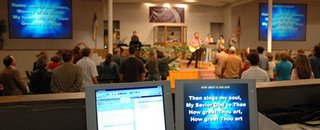
I don’t think we’ll ever return to the days when people used to line up around the block to hear Harry Emerson Fosdick preach forty-minute sermons, or when the major newspapers used to run Monday-morning summaries of the previous day’s pulpiteering. But I wouldn’t want to mutter “ashes to ashes, dust to dust” over the traditional sermon, either. It’s proven remarkably durable over the years, despite each generation’s attempt to replace it with something else.
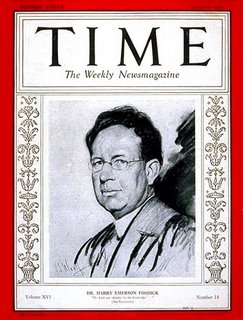 Yesterday’s New York Times had a couple of articles that got me to thinking about this whole business of preaching. One article notes that Protestant theological seminaries continue to be filled with students, but that (1) these are mostly mature students, and (2) comparatively few of the younger students are interested in becoming pastors of churches after they graduate. (This is nothing new to me; I could see these trends beginning more than fifteen years ago, back when I was a seminary admissions director – but it seems somehow significant that the Times has discovered these factoids and deemed them worthy of publication.) The second article, from the same issue of the same newspaper, focuses on how the spoken word is becoming trendy again, and how public lectures on a variety of topics are becoming some of the hottest tickets in the Big Apple (Neela Banerjee, “Students Flock to Seminaries, but Fewer See Pulpit in Future,” and Dinitia Smith, “In the Age of the Overamplified, a Resurgence for the Humble Lecture,” both articles in the New York Times, March 17, 2006).
Yesterday’s New York Times had a couple of articles that got me to thinking about this whole business of preaching. One article notes that Protestant theological seminaries continue to be filled with students, but that (1) these are mostly mature students, and (2) comparatively few of the younger students are interested in becoming pastors of churches after they graduate. (This is nothing new to me; I could see these trends beginning more than fifteen years ago, back when I was a seminary admissions director – but it seems somehow significant that the Times has discovered these factoids and deemed them worthy of publication.) The second article, from the same issue of the same newspaper, focuses on how the spoken word is becoming trendy again, and how public lectures on a variety of topics are becoming some of the hottest tickets in the Big Apple (Neela Banerjee, “Students Flock to Seminaries, but Fewer See Pulpit in Future,” and Dinitia Smith, “In the Age of the Overamplified, a Resurgence for the Humble Lecture,” both articles in the New York Times, March 17, 2006).If there’s anything to this trend of rejecting high-tech glitz and returning to the simplicity of the talking head, then perhaps the churches that are so eagerly jumping on the bandwagon of rear-projection screens and computer animations have hurled themselves into a Keystone Cops car that’s careening off in precisely the wrong direction. For who has been offering “the humble lecture” longer than Protestant preachers? (I’d like to think we do it well, but that’s for our listeners to decide.) Far be it for the Times writer to think in such terms, however; her range of vision is limited to public library and museum programs.
 I still think there’s a place for the traditional sermon in our wired world. There’s something real, and authentically human, about people talking to other people, with no more electronic assistance than perhaps a microphone. Garrison Keillor has reminded us, through thirty years of immensely popular Prairie Home Companion broadcasts, that radio can still be more than either an endless parade of vacuous top-40 tunes or a killing field for victims of right-wing talk-radio hosts. His Lake Wobegon tales teach us there’s still such a thing as the human imagination, and that it can be accessed through the ears as well as the eyes.
I still think there’s a place for the traditional sermon in our wired world. There’s something real, and authentically human, about people talking to other people, with no more electronic assistance than perhaps a microphone. Garrison Keillor has reminded us, through thirty years of immensely popular Prairie Home Companion broadcasts, that radio can still be more than either an endless parade of vacuous top-40 tunes or a killing field for victims of right-wing talk-radio hosts. His Lake Wobegon tales teach us there’s still such a thing as the human imagination, and that it can be accessed through the ears as well as the eyes.So, enough blogging for today. Off I go to write the sermon...
Friday, March 17, 2006
March 17, 2006 - Death of a Poet
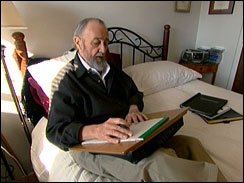 Ken Brewer died on Wednesday at the age of 64. The cause? Pancreatic cancer, with which he was diagnosed only last June. Evidently, his response to the news that he had this deadliest, most incurable of cancers was to take up his pen and write. He spent the last months of his life writing poetry at a rate he described as a “fever pitch.” Ironically, after a lifetime of writing poetry, it is these death poems – written, I suppose, in the spirit of Dylan Thomas, who himself advised poets to "rage, rage against the dying of the light" – that have given Ken Brewer his fifteen minutes of fame. I think, from what little I’ve seen of his work, that he deserves a good deal more fame than that – but we’ll see if the world accords him more than passing notice.
Ken Brewer died on Wednesday at the age of 64. The cause? Pancreatic cancer, with which he was diagnosed only last June. Evidently, his response to the news that he had this deadliest, most incurable of cancers was to take up his pen and write. He spent the last months of his life writing poetry at a rate he described as a “fever pitch.” Ironically, after a lifetime of writing poetry, it is these death poems – written, I suppose, in the spirit of Dylan Thomas, who himself advised poets to "rage, rage against the dying of the light" – that have given Ken Brewer his fifteen minutes of fame. I think, from what little I’ve seen of his work, that he deserves a good deal more fame than that – but we’ll see if the world accords him more than passing notice.I haven’t heard of Brewer’s work before – and, in fact, as with too many poets, it seems that most of his books are out of print. It’s also frustratingly hard to find any of his poetry online – just snippets here and there.
I do discover a feature story that CBS News did on him back in December. It includes a couple of video clips of him reading his poetry. One of the poems he read to the television camera I decide to write down. Here it is (although, because I’ve transcribed it from oral form, the punctuation and line breaks may not be quite as the poet intended):
“The Measure”
by Kenneth Brewer
I measure my life in friends
and I am humbled by the numbers,
the quality,
the style, path, policy and grace.
I measure my life in days
when friends write,
when we converse as they sit by my bed,
read poems and listen.
I measure my life in family
who speak through tears,
who serve me meals on a wicker tray,
who pray and love and float.
I measure my life in pine siskens
who entertain me in feeders outside my window,
and Gus, the schnauzer,
who curls next to me in bed.
I measure my life in friends
who do not know my sins,
who hug my shrunken body,
who break open my heart with words.
I measure my life in cancer
that has taught me how to measure my life.
He’s right about that. Cancer – for those of us who have it – does have a way of teaching us how to measure our lives. I suppose that many of those, like Ken Brewer, who are unfortunate enough to have one of the deadliest types of cancer, achieve a certain clarity of purpose right quickly. They have heard their doctor soberly say, “Go put your affairs in order.” And so they do. If the person is a poet, then that may mean, “Go write more poems.”
In reading a news article about him, I discover another thing Ken Brewer said, something he had learned about cancer:
“Brewer experienced an evolution of language as he wrote about cancer. He noticed all the ‘military terms,’ such as ‘fight, battle, kill,’ and he used those in his early poems. But gradually he came to feel that he should talk about cancer in a different way. ‘It’s your cancer – a house guest who stays longer than you wanted him to. You kill your spirit when you use military language. There are other parts of you that need to be healed. I focus now on spiritual healing.’”
(Dennis Lythgoe, “Utah Poet Writes at a Fever Pitch,” Deseret Morning News, December 18, 2005)
 I’ve been using that military language some, in talking about my own cancer. It’s hard not to. A lot of the stuff written about cancer treatment – the “War on Cancer” – does talk about “attacking” the malignant cells, about “killing”them. I’ve heard Rituxan, the medicine I’m taking, described as a “smart bomb” that goes right to the cancer cells and obliterates them. There’s a sort of righteous rage behind that choice of words (“Yes, officer, I confess: I killed that cancer cell, but you have to understand, I did it in self-defense”).
I’ve been using that military language some, in talking about my own cancer. It’s hard not to. A lot of the stuff written about cancer treatment – the “War on Cancer” – does talk about “attacking” the malignant cells, about “killing”them. I’ve heard Rituxan, the medicine I’m taking, described as a “smart bomb” that goes right to the cancer cells and obliterates them. There’s a sort of righteous rage behind that choice of words (“Yes, officer, I confess: I killed that cancer cell, but you have to understand, I did it in self-defense”).Ken Brewer figured out, over time, that the military language wasn’t doing him any good. Cancer, after all, is not some foreign microbe that infiltrates our bodies and sets up housekeeping like an unwelcome squatter. Cancer is our bodies. It is our very own cells, whose mutinous growth has been mapped out in advance by rebel strands of our own DNA. Certain cancers, it seems, are pre-programmed into our bodies at birth. If we live long enough, eventually our genetic code will trigger the mutation, and the disease will be off and running.
So does it make sense to speak of “killing” the cancer, to blow those errant cells to smithereens? I’m not sure it does – as emotionally satisfying as it may seem, at times, to vent our anger in such a way. If what I’ve learned about lymphoma is correct, then I’m probably going to have the disease the rest of my life. It’s part of me, and always will be. If Ken Brewer’s right, then maybe I need to embrace it – although I suppose that embrace could be a wrestler’s grip, like Jacob’s at the fords of the Jabbok:
 “Jacob was left alone; and a man wrestled with him until daybreak. When the man saw that he did not prevail against Jacob, he struck him on the hip socket; and Jacob’s hip was put out of joint as he wrestled with him. Then he said, ‘Let me go, for the day is breaking.’ But Jacob said, ‘I will not let you go, unless you bless me.’” (Genesis 32:24-26)
“Jacob was left alone; and a man wrestled with him until daybreak. When the man saw that he did not prevail against Jacob, he struck him on the hip socket; and Jacob’s hip was put out of joint as he wrestled with him. Then he said, ‘Let me go, for the day is breaking.’ But Jacob said, ‘I will not let you go, unless you bless me.’” (Genesis 32:24-26)Genesis portrays the solitary figure of Jacob, silhouetted against the rising sun, limping away from that mysterious encounter – but the wiser for it. Cancer may indeed leave us limping, but if we’re canny and persistent, perhaps we can wrestle a blessing out of it after all.

Thursday, March 16, 2006
Yetalech?
For more poems visit Tewodros Abebe’s website
Click on poem to enlarge!



[Click here] to read in pdf format.
Wednesday, March 15, 2006
Why Do People Vote Right-wing?
...the political appeal of Right-wing calls to order comes from society's anxiety for the ever-increasing possibility of catastrophic disorder. From the viewpoint of an isolated individual, it makes no difference if disorder is produced by another individual for random reasons, or by a progressive collective that does it as part of a political action. It does not matter if it is a criminal, a madman, a union striking, or an anti-capitalist group doing direct action: whenever there is fear of catastrophic disorder and of the dissolution of social bonds, Right-wing calls to order find a fertile soil. More
This is a thoughtful article that seeks to stop blaming or denigrating people who support what is obviously not in their best interests.
People actually aren't stupid and they generally seek to act rationally and make the best decisions for their particular circumstances. It drives me crazy when progressives talk about the "stupidity of the masses" etc.
In addition, there is a fair bit of psychological study in the scholarly and popular literature about why people are self-destructive. As an example, why do women stay with abusive men?
By understanding this, we can reduce our negative judgements on people, increase the compassion we like to think we feel as progressives, and learn best how to effect change individuals (without being condescending).
More Philosophy & Reflection, General Politics
Turn a Parking Space into a PARK
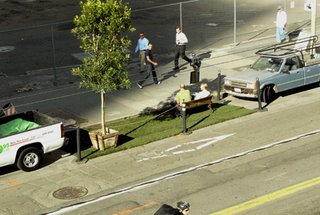
How to Turn a Parking Space into a PARK, "Just be sure you pay the meter."
More green design by Treehugger and Cameron Sinclair's Architecture for Humanity
Filed under: Art, Urban Issues, Environment
Tuesday, March 14, 2006
March 14, 2006 - Historical Artifact
 This morning I’m walking down the street in my neighborhood, when I pass a snazzy, purple Volkswagen Beetle parked along the street. I’m admiring the car’s immaculate paint job when I notice a word at the bottom of the New Jersey license plate. It says, “Historic.”
This morning I’m walking down the street in my neighborhood, when I pass a snazzy, purple Volkswagen Beetle parked along the street. I’m admiring the car’s immaculate paint job when I notice a word at the bottom of the New Jersey license plate. It says, “Historic.”Now wait a minute! A Volkswagen Beetle – historic? But evidently it is, nowadays.
Suddenly, I’m feeling my age. Our family had a Beetle when I was a kid. Priced as a bargain vehicle, it was the only set of wheels we could afford, when it came time to buy a second car for my mother to drive. That blue Beetle became the suburban chariot that schlepped my brothers and me to all our after-school events, Scout meetings and such.
 The Volkswagen was a novelty to my friends. A sure-fire way to impress them was to borrow the car keys from Mom, then take them out into the driveway and open up the front and rear hatches: showing them the engine in the back and the trunk in the front.
The Volkswagen was a novelty to my friends. A sure-fire way to impress them was to borrow the car keys from Mom, then take them out into the driveway and open up the front and rear hatches: showing them the engine in the back and the trunk in the front.Sometimes, on really cold days, the thing wouldn’t start. Then, we’d have to push it down the driveway into the street (it wasn’t very heavy, as cars go), and point it down the hill. We’d hop in, and my mother would then take her foot off the brake and let it roll rapidly downward, popping the clutch to start the thing – all of which we hoped would happen before we rolled out into heavy traffic on Washington Street. For a kid of 11 or 12, it didn’t get much better than that.
This car was part of my growing up. It can’t be a classic already. It just can’t.
But it is. Tempus fugit.
 “For all our days pass away under your wrath;
“For all our days pass away under your wrath;our years come to an end like a sigh.
The days of our life are seventy years,
or perhaps eighty, if we are strong;
even then their span is only toil and trouble;
they are soon gone, and we fly away....
So teach us to count our days
that we may gain a wise heart.”
(Psalm 90:9-10, 12)
“Counting our days” was what passed for wisdom in the world of the Hebrew Bible. When they counted their days, those ancient Hebrews came up with the proverbial “threescore years and ten” – seventy, in other words – as the normal upper limit on human life. A very few might live on to eighty (if they were strong), but this was considered exceptional.
If all goes well with my CT Scans (the one I had done yesterday, and the one I’ll have in mid-May, following my sixth chemo treatment), I’ll be in remission by the time I turn 50 in October. That will give me twenty more years until I hit the threescore-years-and-ten – although, as we all know, people in our culture with access to good nutrition and medical care can ordinarily expect to live a good deal longer than that.
 Assuming I do make it into remission – as Dr. Lerner seems confident I will – how long will it last? Could I be doing this chemotherapy thing again in another five years? Another ten? Will chemo even be the treatment of choice at that time (considering how rapidly the scientists are making new discoveries)? Maybe, when and if the cancer comes back, I’ll be receiving vaccine therapy instead (like the experimental protocol the folks at Sloan-Kettering wanted me to receive as a clinical trial – before the revised grading of my cancer disqualified me). Maybe I’ll have a stem-cell transplant. Maybe there will be some new treatment no one’s even thought of yet.
Assuming I do make it into remission – as Dr. Lerner seems confident I will – how long will it last? Could I be doing this chemotherapy thing again in another five years? Another ten? Will chemo even be the treatment of choice at that time (considering how rapidly the scientists are making new discoveries)? Maybe, when and if the cancer comes back, I’ll be receiving vaccine therapy instead (like the experimental protocol the folks at Sloan-Kettering wanted me to receive as a clinical trial – before the revised grading of my cancer disqualified me). Maybe I’ll have a stem-cell transplant. Maybe there will be some new treatment no one’s even thought of yet.It all seems so hypothetical. Before getting cancer, I would have routinely expected to live into my eighties or nineties. I still might – but there seem to be so many more factors, now, that could affect my lifespan.
“Counting my days” doesn’t seem so wise, after all. When I see a purple Volkswagen Beetle on the street, I should probably just enjoy it for what it is, in the here and now.
Now that’s wisdom.
So ridiculous you just have to laugh (O'Reilly Attacks...)
So ridiculous I never know whether to laugh or cry. It's funny, until you realize people actually listen to O'Reilly and parrot his words back and forth between each other as thought it's the gospel.
Monday, March 13, 2006
March 13, 2006 - Breathing Lessons
 Unless we’ve got some sort of respiratory problem, most of us spend little or no time each day thinking about our breathing. It’s one of the body’s “autonomic” functions – breathing happens automatically, whether we’re thinking about it or not.
Unless we’ve got some sort of respiratory problem, most of us spend little or no time each day thinking about our breathing. It’s one of the body’s “autonomic” functions – breathing happens automatically, whether we’re thinking about it or not.On two different occasions today, my attention is focused on my own breathing. Those two circumstances are as different as different can be.
The first takes place this afternoon at Ocean Medical Center (Brick Hospital), where I’ve gone for a CT Scan. I’m halfway through my chemo treatments, so this is the mid-point check on how much my tumors have diminished in size. It will be several days before I hear the results from Dr. Lerner.
I’ve been through this procedure before. Drink a banana-flavored pseudo-milkshake: half of it three hours before the test, the rest of it moments before. Then, lie down on a narrow gurney, feet pointing in the direction of the large, white donut that is the CT Scan machine. Extend an arm, for it to be pierced with a special IV needle, so the contrast dye can be injected moments before the test. Now, hands over your head, and do what the machine tells you.

The machine? Yes, the machine. A disembodied, robotic voice repeats this three-part command a dozen or so times, as a whirring electric engine moves my body jerkily through the donut: “Breathe in. Hold it. Breathe.” For this scan of my chest and abdomen, my belly must be absolutely still at the critical moments – not rising and falling as it does with normal breathing.
Each time the robotic voice says, “Breathe in,” I fill my lungs with air – not too much, because I might hyperventilate, but a larger-than-normal breath all the same. Then I have to hold that breath a little longer than feels comfortable, before abruptly, almost explosively expelling it on the “Breathe” command. Despite all this deep breathing, there’s a breathless feeling about it all. As familiar as we all are with the act of breathing, it feels unnatural to breathe on command.
The second occasion I have to reflect on my breathing is this evening, at our church’s informal healing service. It’s a peaceful, restful setting. The sanctuary lights are dimmed, with candles flickering on the communion table. Gentle, Taizé music is playing softly over the sound system. There are periods of silence, during which the other worshipers and I sit quietly.
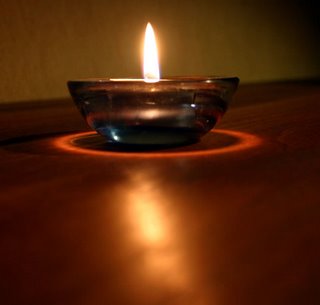 In such a setting, it’s natural to become aware of one’s own breathing. It’s a time-honored meditation technique, in fact, to reflect on one’s own breathing – and perhaps to utter a simple, rote prayer on the “in” breath and another on the “out” breath. I don’t whisper any such prayer tonight, but I do focus on my breathing – and the more I do, the more relaxed I feel. By the time some of us – myself included – come forward for prayer and the laying on of hands, I’m feeling relaxed indeed, and at peace.
In such a setting, it’s natural to become aware of one’s own breathing. It’s a time-honored meditation technique, in fact, to reflect on one’s own breathing – and perhaps to utter a simple, rote prayer on the “in” breath and another on the “out” breath. I don’t whisper any such prayer tonight, but I do focus on my breathing – and the more I do, the more relaxed I feel. By the time some of us – myself included – come forward for prayer and the laying on of hands, I’m feeling relaxed indeed, and at peace.There’s quite a contrast between this day’s two experiences of intentional breathing. Each, in its own way, is supposed to make me well. Yet the first increases my anxiety, while the second makes me feel at peace. I’m not suggesting that CT Scans be conducted any differently – there are good medical reasons why it’s best to hold one’s breath while the pictures are being taken. I’m just observing an interesting contrast between the two.
This contrast seems symbolic of these two ways of healing that are meant to be complementary: the clinical and the spiritual. A truly holistic treatment, for cancer or any other disorder, must include something of both.
Breathe in... breathe out. It’s the ceaseless rhythm of life.
March 10, 2006 - Death Be Not Proud
While that statement may sound unusual, to me it’s commonplace enough. I’m a minister. That’s what I do.

Yesterday evening, Claire and I went to the funeral home to see Gwen, a member of our church who just lost her husband, Jack, to old age and Alzheimer’s Disease. Robin, our associate pastor, is scheduled to conduct his funeral service, but I felt well enough last evening to go pay my respects, and so I did. It’s a familiar-enough routine: enter the funeral home, greet the funeral directors on the way in (I see a lot of them in my line of work), walk into the room with the open casket over against one wall, and make my way through the crowd of friends and family to find the little cluster of those who are most closely touched by this death.
They don’t teach you in seminary what to say in such situations. I’ve long since learned that what you say isn’t so important anyway. It’s being there. There are heavily symbolic aspects to my role as a pastor, and this is one. When I’m in a room, the church is there too. Some would go further and say that when I’m there, God is there. Although I’d never be so theologically arrogant as to claim that God somehow rides in on my coattails, I’ve become used to the fact that there’s a symbolic aspect to this work. It’s a matter of representation. Just as salespeople out on the road represent their companies, so my presence represents God in times such as this.
 Gwen was glad to see us. We stood with her by the casket and marveled at this wonder of a human body that once had been animate, but now lay cold and still. The face – assisted by the mortician’s skilled labors – was an excellent likeness. Jack had been in declining health, both mentally and physically, for years – but last night there was no sign of it. He looked like himself, as we all remembered him from better days. To Gwen, who had been so devoted to him, that was a blessing beyond words.
Gwen was glad to see us. We stood with her by the casket and marveled at this wonder of a human body that once had been animate, but now lay cold and still. The face – assisted by the mortician’s skilled labors – was an excellent likeness. Jack had been in declining health, both mentally and physically, for years – but last night there was no sign of it. He looked like himself, as we all remembered him from better days. To Gwen, who had been so devoted to him, that was a blessing beyond words.This morning I meet for an hour or so with David and Lauren, who have just lost their wife and mother, Madeline, to ovarian cancer. She was in her fifties – too young, anyone would agree. I’m planning to conduct her memorial service in a few weeks (which we think we’ve timed right, in between my chemo treatments). We sit, the three of us, in my study at the church, mostly sharing stories. I’ve found that’s the most helpful thing to do in such a situation. The stories somehow conjure the person in our minds, so we can – when the time is right – say farewell.
Dave and Lauren had ample opportunity to say farewell to Madeline. With the slow progression of her disease, they knew she was dying. So did she. She talked about it freely. My last conversation with her was on the phone, at a time when I was too sick to leave the house (though Robin went over the next day and brought her communion). In the end, it was only a matter of time, until the family dared whisper the wish that finally comes to so many hospice rooms, the wish that it would soon be over.
 As hard as it may be for those who have not lived through this kind of protracted bereavement to understand, this can be the most loving wish imaginable. The family have been journeying with their loved one through the sort of reverse pregnancy that is dying, and they’ve come to the point where they wish this new reality would be born: this new life that we believe begins at the instant of death, but whose details we cannot imagine until we ourselves experience it. When a baby is born, the pre-birth existence in the womb remains a dark mystery. Similarly, when a person dies, the life that awaits beyond this one is swathed in mystery. We stand, as family and friends and church, at the edge of that sweet but mysterious darkness, and our job is let go, to release the grip on the hand, to say it’s OK, you can go, it’s all right, we’ll all be all right.
As hard as it may be for those who have not lived through this kind of protracted bereavement to understand, this can be the most loving wish imaginable. The family have been journeying with their loved one through the sort of reverse pregnancy that is dying, and they’ve come to the point where they wish this new reality would be born: this new life that we believe begins at the instant of death, but whose details we cannot imagine until we ourselves experience it. When a baby is born, the pre-birth existence in the womb remains a dark mystery. Similarly, when a person dies, the life that awaits beyond this one is swathed in mystery. We stand, as family and friends and church, at the edge of that sweet but mysterious darkness, and our job is let go, to release the grip on the hand, to say it’s OK, you can go, it’s all right, we’ll all be all right.When that fierce intimacy is ended, I come in, and help everyone sort out what has just happened. I ask questions, I listen to stories, I hand over the kleenex box, I write down those things that will become part of the funeral service. Again, my role is largely symbolic. The family has not come to see me; they have come hoping to see God. They yearn to be assured that God was there, too, in that sickroom, and they yearn to be assured God is with them still, as they prepare for one of life’s most difficult roles, that of bereavement. There’s not much more I really have to do than that – just be there, listen, let them talk as they have the need, and hope that my presence somehow speaks to them of God’s far more significant presence.
If truth be told, I feel like a pretty poor stand-in for God much of the time (and I know most of my ministerial colleagues feel the same way). But it’s not about us. It’s about God, and the fact that God somehow uses this frail human institution called the church, and its even frailer representatives called ministers, to remind people how much they are loved.
Poet and undertaker Thomas Lynch reflects on people like me, and what we do:
"Uncles find nickels behind our ears. Magicians pull rabbits from out of hats. Any good talker can preach pie in the sky or break out the warm fuzzies when the time is right. But only by faith do the dead arise and walk among us or speak to us in our soul's dark nights.
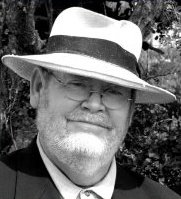 So rabbi and preacher, pooh-bah and high priest do well to understand the deadly pretext of their vocation. But for our mortality there'd be no need for churches, mosques, temples, or synagogues. Those clerics who regard funerals as so much fuss and bother, a waste of time better spent in prayer, a waste of money better spent on stained glass or bell towers, should not wonder for whom the bell tolls. They may have heard the call but they've missed the point. The afterlife begins to make the most sense after life – when someone we love is dead on the premises. The bon vivant abob in his hot tub needs heaven like another belly button. Faith is for the heartbroken, the embittered, the doubting, and the dead. And funerals are the venues at which such folks gather.” (Thomas Lynch, The Undertaking, Penguin, 1997, pp. 80-81.)
So rabbi and preacher, pooh-bah and high priest do well to understand the deadly pretext of their vocation. But for our mortality there'd be no need for churches, mosques, temples, or synagogues. Those clerics who regard funerals as so much fuss and bother, a waste of time better spent in prayer, a waste of money better spent on stained glass or bell towers, should not wonder for whom the bell tolls. They may have heard the call but they've missed the point. The afterlife begins to make the most sense after life – when someone we love is dead on the premises. The bon vivant abob in his hot tub needs heaven like another belly button. Faith is for the heartbroken, the embittered, the doubting, and the dead. And funerals are the venues at which such folks gather.” (Thomas Lynch, The Undertaking, Penguin, 1997, pp. 80-81.)After more than twenty years of doing this, I think I do understand what Lynch calls “the deadly pretext of my vocation.” I’m learning that the fact that I have a disease that could kill me doesn’t make a bit of difference. We’re all going to die. Some do it sooner than others, but eternity has the same duration, regardless. While I have breath, I continue to feel privileged to be welcomed into that intimate place where family members confront their deepest griefs and fears, hold tight to one another for comfort – and look for God to show up, somehow, just beyond their peripheral vision... as I walk into a room, bald head and all.
Wednesday, March 8, 2006
March 8, 2006 - By the Inlet
 This afternoon, after I go for my weekly blood test – my counts are just fine, by the way – Claire and I drive down to the ocean and go for a walk on the beach. It’s a crisp, cold day – and pretty windy, besides – but the sun is bright, and the sea is lovely. I’ve always liked going down to the ocean in the off-season – a memory that goes back to my early years, growing up here on the Jersey Shore – though it seems we rarely get down there anymore. Our little town of Point Pleasant Beach gets inundated with visitors in July and August, so much so that it hardly seems to be our town anymore. Go down to the beach in these winter months, though, and you may only have to share it with the seagulls. That’s the way it is today: blessedly deserted.
This afternoon, after I go for my weekly blood test – my counts are just fine, by the way – Claire and I drive down to the ocean and go for a walk on the beach. It’s a crisp, cold day – and pretty windy, besides – but the sun is bright, and the sea is lovely. I’ve always liked going down to the ocean in the off-season – a memory that goes back to my early years, growing up here on the Jersey Shore – though it seems we rarely get down there anymore. Our little town of Point Pleasant Beach gets inundated with visitors in July and August, so much so that it hardly seems to be our town anymore. Go down to the beach in these winter months, though, and you may only have to share it with the seagulls. That’s the way it is today: blessedly deserted.We don’t stay long. The wind is just a bit too cold for comfort, and besides, my stamina for any kind of exercise is nearly non-existent. We drive over to the nearby 7-Eleven, pick up a couple of hot chocolates, then head over and park by the Manasquan Inlet.
 The Inlet is part of the Inland Waterway, a major navigation route for small boats. It’s actually the mouth of the Manasquan River, but the Point Pleasant Canal empties into it about a mile upriver. This means the mouth of the river serves as the Canal’s outlet to the ocean – the only way into or out of the northern part of Barnegat Bay. At certain times of year, you can sit by the Inlet and watch a constant parade of boats, both recreational and commercial fishing vessels, chugging through this narrow channel between the concrete sea-walls. The lore among local pastors is that this is where our parishioners go when they’re playing hooky from church on Sunday morning: they sit in their cars by the Inlet, with bagels and the New York Times. At this late-afternoon hour, though, the prime parking spaces in the Inlet lot are only about one-third filled. As for the Inlet itself, the only marine traffic we see is one small Coast Guard boat, which makes the passage out into the ocean as we watch.
The Inlet is part of the Inland Waterway, a major navigation route for small boats. It’s actually the mouth of the Manasquan River, but the Point Pleasant Canal empties into it about a mile upriver. This means the mouth of the river serves as the Canal’s outlet to the ocean – the only way into or out of the northern part of Barnegat Bay. At certain times of year, you can sit by the Inlet and watch a constant parade of boats, both recreational and commercial fishing vessels, chugging through this narrow channel between the concrete sea-walls. The lore among local pastors is that this is where our parishioners go when they’re playing hooky from church on Sunday morning: they sit in their cars by the Inlet, with bagels and the New York Times. At this late-afternoon hour, though, the prime parking spaces in the Inlet lot are only about one-third filled. As for the Inlet itself, the only marine traffic we see is one small Coast Guard boat, which makes the passage out into the ocean as we watch. Then we see it, poking up through the surface of the water. At first we mistake it for a sea bird, but the outline is just too distinctive. We’ve seen that dark silhouette plenty of times along the Scottish coast (and even photographed it), but rarely are we so lucky as to see one here. It’s a seal – treading water right there in the middle of the Inlet, as plain as day. After a few moments of looking around (probably enjoying the good fortune of being able to take a long, leisurely look, with no boats to cause interruption), the seal submerges, and we see it no more.
Then we see it, poking up through the surface of the water. At first we mistake it for a sea bird, but the outline is just too distinctive. We’ve seen that dark silhouette plenty of times along the Scottish coast (and even photographed it), but rarely are we so lucky as to see one here. It’s a seal – treading water right there in the middle of the Inlet, as plain as day. After a few moments of looking around (probably enjoying the good fortune of being able to take a long, leisurely look, with no boats to cause interruption), the seal submerges, and we see it no more.It’s a special showing the Universe appears to have arranged, just for us. The people sitting in the other cars in the lot would have had to be looking at that particular patch of water at just the right time, in order to see it. The seal is a reminder to us that there’s a whole world out there we rarely even think about, so wrapped up are we in the sheer daily-ness of living. Beneath the waves, the seals slice through the black water, doing their barrel rolls and loop-de-loops, living their feckless, fishing life. This afternoon, for ever so brief an instant, we have come into contact with their world.
Note to self: go down to the Inlet more often. It’s good therapy.
